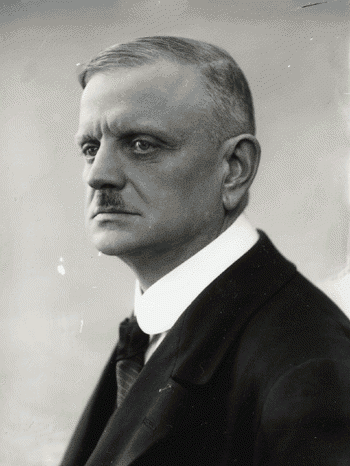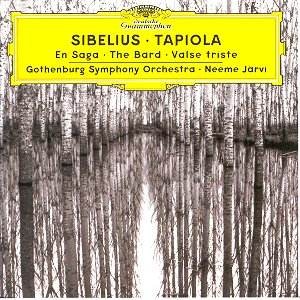vendredi, 22 février 2013
Sibelius and the God of the Wood

Tapiola:
Sibelius & the God of the Wood
By Christopher Pankhurst
Ex: http://www.counter-currents.com/
Tapiola is the last major work composed by Jean Sibelius. It was commissioned by the New York conductor Walter Damrosch at the beginning of 1926 and was premiered on Boxing Day of the same year. Damrosch asked for a symphonic poem with the choice of subject left to the composer. For inspiration Sibelius turned, as he so often did, to the Kalevala, the collection of Finnish folklore that looms so large in his work.
Sibelius was 60 when he began work on Tapiola and his reputation as Finland’s greatest composer was already sealed. He had become a quasi-official national composer due to his overt nationalism in supporting Finland’s right to independence against both Russian and Swedish domination. It is probably no great exaggeration to say that he was one of the most popular composers of the 20th century, at least in Scandinavian and Anglophone countries. In the heart of the European musical culture there was a large degree of suspicion about his popularity and a feeling that he was insufficiently modern, meaning that he was not in thrall to Schoenberg. Germany did come to love Sibelius, albeit in the 1930s and ’40s when he became a semi-official Nazi composer [2], allegedly telling the German troops in a message, “I wish with all my heart that you may enjoy a speedy victory.”[1] He thus became a favourite of both Berlin and New York.
Tapio is the god of the woodland and Tapiola is his home. Sibelius’s tone poem paints a rich picture of this homeland and succeeds in animating it with an array of supernatural entities. The score of Tapiola contains an explanatory quatrain:
Wide-spread they stand, the Northland’s dusky forests,
Ancient, mysterious, brooding savage dreams,
Within them dwells the Forest’s mighty God,
And wood-sprites in the gloom weave magic spells.
Humanity is fortunate indeed that Sibelius devoted his energies to music rather than poetry, but note nonetheless that “Forest” as well as “God” is capitalized in the third line. For Sibelius, there is a subtle and important identification to be made between the two.
 The music begins with a bold melodic motif that is repeated throughout. In fact, the piece has been called monothematic. This should not be seen as a criticism, however. What Sibelius does, and does brilliantly, is to unfold and examine this motif with varying emphases and with a wide range of orchestral techniques. As the work progresses, there is a sense that these discrete and distinctive reformulations of an underlying theme somehow evoke into being the varied life forms of the forest. The manifold entities are unique yet unified in a higher organizing principle, the tone poem’s motif itself, which yields to successive embodiments yet remains animated by its own structural discipline. The mood of the piece is neither light nor dark; it does not seem to be expressive of individual emotion. Instead it is a restive depiction of the forest with all its implied distance from human civilization.
The music begins with a bold melodic motif that is repeated throughout. In fact, the piece has been called monothematic. This should not be seen as a criticism, however. What Sibelius does, and does brilliantly, is to unfold and examine this motif with varying emphases and with a wide range of orchestral techniques. As the work progresses, there is a sense that these discrete and distinctive reformulations of an underlying theme somehow evoke into being the varied life forms of the forest. The manifold entities are unique yet unified in a higher organizing principle, the tone poem’s motif itself, which yields to successive embodiments yet remains animated by its own structural discipline. The mood of the piece is neither light nor dark; it does not seem to be expressive of individual emotion. Instead it is a restive depiction of the forest with all its implied distance from human civilization.
Towards the end, the music recedes to silence from which emerges a remarkable storm of sound. The strings slide up and down in a confusion of dissonance whilst brass intrudes with ominous intent. This is the presence of Tapio and it induces a sensation of panic. Like the Greek Pan from whom we have the word “panic,” Tapio seems to bring the terror of nature, of uncontrolled and unconquered forces. Beyond the familiarity of the Northern European village, or still more outside the modern city, the forest holds a certain primal terror embodied in the numinous figure of the woodland God.
After the cacophony of Tapio’s appearance the music returns to a form of the recurring motif, now calmer and quieter. The meeting with the God and the terror invoked thereby have led to a more mature state of being and greater wisdom. Something has been learned from the woodland spirits.

Damrosch was delighted with Sibelius’s work and wrote to him that, “only a Norseman could have written it.” Although this judgement plays into the hands of those who deprecate Sibelius for his provincialism, it is astute. Sibelius conjures a numinous experience in this piece. The numen is the presiding god of a particular place. The word “numen” is related to the Latin nuere, “nod,” and to the Greek neuein, “incline the head,” indicating an assent or command. Thus, the word indicates the effects of the power of the local deity. This formal understanding of the numinous is particularly applicable to Sibelius.
Musicologists tend to be impressed with Sibelius’s use of atonality in the climactic encounter with Tapio; it suggests an incipient respect for avant-gardism largely absent from much of his other work. The interesting thing about the way that Sibelius uses this atonal moment though is that it is subservient to a greater overarching musical narrative. There is no reason why atonality cannot be used in music; it is especially effective in horror film music, for example. The problem with atonality is the hubristic attitude of its proponents who regard their listeners as imbecilic dullards needing to be shocked out of their 19th-century preoccupations.
The moment of confrontation with Tapio is actually difficult to listen to calmly. It impinges on bodily sensation, creating a constriction of breath and raising the hairs at the back of the neck. When it passes and calm is restored, the calmness is enhanced and more deeply appreciated. Like ghost stories that disrupt the natural order only to reinforce it at the end, the disorientation caused by the numinous panic of facing the God results in a more profound restoration of natural balance and a richer appreciation of the beauty that was always there. For the academic avant-garde this is mere conservatism. But the important point is that Sibelius’s music is deeply rooted in the primal landscape of his homeland. Regardless of the stories of the Kalevala that inspired him, his art is a primal expression of the numinous due to the genius of his interfusing melody with the landscape. His music is grounded, rooted; almost mystically expressive of the land. The arid intellectuality of much twentieth century composition withers away in comparison.
Tapiola benefits from a comparison with a later work, Tabula Rasa by Arvo Pärt. Like Tapiola, Tabula Rasa is a meditation on a theme and it submits its theme to a series of experimental unfoldings. In its first movement, Ludus, the melody is deconstructed and its chromatic implications are worked out to great effect. Like Tapiola, Tabula Rasa has a certain numinous, or mystical, quality but of a quite different type. Tabula Rasa is a fractal meditation, closely examining a natural unfolding such as the growth of a leaf. It is mystical in a Blakean sense, a revealing of the enfolded mysteries of nature, and whilst ably communicated through art it is a visionary moment of realisation granted only to the few. It is an illuminated manuscript in music.
Sibelius’s confrontation with his God is not visionary in the same sort of way. It is the feeling of being alone in the woods, far from humanity. It is a universal feeling (at least amongst Northern Europeans) and is consonant with pre-civilizational fears. The feelings of loneliness and vulnerability are the guards against hubris and the seeds of the numinous.
Tapiola is a beautifully pagan work of art. It expresses the numinous directly without recourse to elaborate theological concepts. It also shows that any musical technique is a valid one for the artist so long as he utilises it in furtherance of man’s engagement with the natural and sacred, not in pursuit of his own intellectual abstractions. Disorientation can have pedagogic value, but only if reorientation subsequently occurs.
Sibelius lived for 30 more years but composed nothing of value in that time. He destroyed his eighth symphony and it remains lost. It is almost as if the confrontation with his God of the woods left him with nothing further to say. He had turned the numinous into art and there is nothing greater for an artist to achieve. Tapiola remains a significant and numinous work of Northern European art.
Note
1. Alex Ross, The Rest is Noise (London: Harper Perennial, 2009), 190.
Article printed from Counter-Currents Publishing: http://www.counter-currents.com
URL to article: http://www.counter-currents.com/2013/02/tapiola-sibelius-and-the-god-of-the-wood/
URLs in this post:
[1] Image: http://www.counter-currents.com/wp-content/uploads/2013/02/Sibelius.jpg
[2] a semi-official Nazi composer: http://www.counter-currents.com/2010/07/sibelius-the-nazis-anatomy-of-a-smear/
00:06 Publié dans Musique | Lien permanent | Commentaires (0) | Tags : musique, jean sibelius, finlande, paganisme |  |
|  del.icio.us |
del.icio.us |  |
|  Digg |
Digg | ![]() Facebook
Facebook



Les commentaires sont fermés.